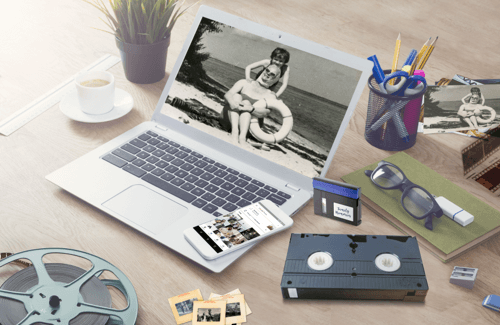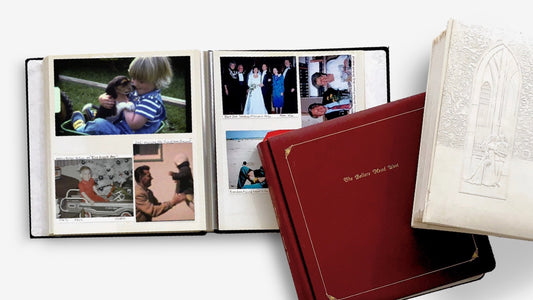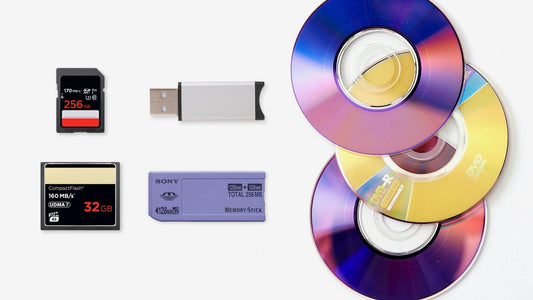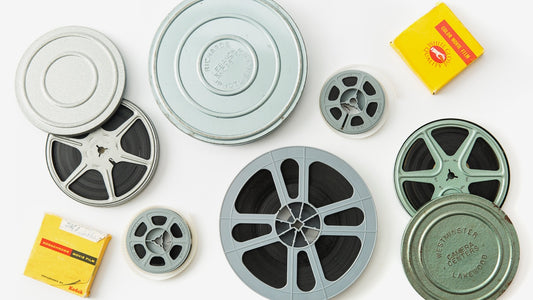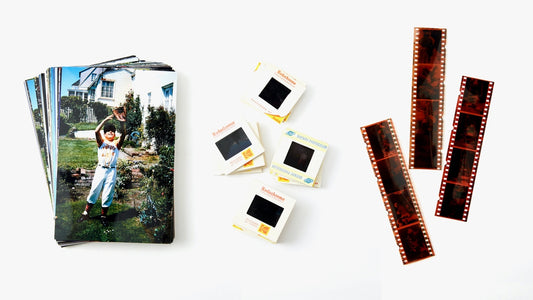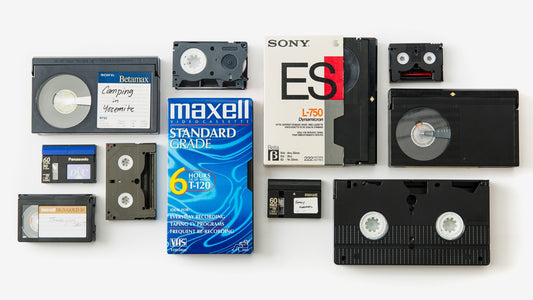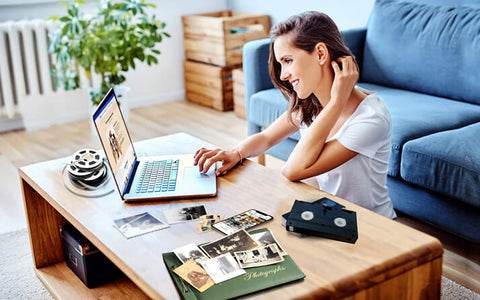Those bulky VHS tapes in your closet contain some of your most cherished memories: first steps, birthday parties, and holiday gatherings with loved ones. But every year they sit unused, they risk fading away completely. The magnetic tape inside wasn't made to last forever. The solution is a VHS to USB conversion, which essentially freezes those moments in time by turning them into modern digital files. This guide will explain why digitizing your tapes is so important for their long-term survival. We’ll cover how to protect your videos from decay, make them easy to watch again, and share them with the people who matter most.
Key Takeaways
- Act Now to Save Fading Tapes: The magnetic tape in your VHS collection degrades over time, so converting them to digital is the only way to stop the decay and protect your family’s history from being lost forever.
- Choose Your Path: DIY or Professional: A DIY conversion is a great project if you're comfortable with technology and have just a few tapes, but a professional service is the best choice for high-quality results, large collections, or a stress-free process.
- Protect Your Digital Files with Backups: Once your videos are digitized, keep them safe by storing copies in multiple locations. Use a combination of cloud storage, your computer, and an external drive to ensure your memories are secure for the long term.
Why Should You Convert VHS Tapes to USB?
If you’ve ever stumbled upon a box of old home movies in your attic, you know that rush of nostalgia. Those tapes hold priceless moments: birthday parties, first steps, and holiday gatherings. But they’re trapped in an outdated format. Converting your VHS tapes to a USB drive isn't just about decluttering; it's about protecting those memories, making them accessible again, and ensuring they can be shared for years to come. Think of it as breathing new life into your family’s history.
Save Your Memories Before They Fade
The hard truth is that VHS tapes weren't built to last forever. The magnetic tape inside them degrades over time, typically within 10 to 20 years. Factors like heat, humidity, and even just sitting on a shelf can cause the video and audio quality to fade, leaving you with a fuzzy, distorted version of your original memory. By choosing to do a video transfer, you’re essentially freezing those moments in time. A digital file on a USB drive doesn’t decay the way a physical tape does, ensuring your memories remain as clear and vibrant as the day they were recorded. It’s the best way to safeguard your family’s legacy from the inevitable effects of time.
Enjoy Your Videos on Modern Devices
Let’s be honest, when was the last time you saw a VCR? These bulky machines have become relics of the past, making it nearly impossible to watch your old home movies. Converting your tapes to USB brings your memories into the present day. You can easily plug a USB drive into your smart TV, laptop, or computer and start watching instantly—no complicated cables or ancient equipment required. This simple change makes it easy to gather the family for a movie night or just take a quiet trip down memory lane on your own. It’s about making your memories a part of your life again, not just something stored away in a box.
Share and Store Your Videos with Ease
One of the best parts of digitizing your home movies is how simple it becomes to share them. You can send a video file to a relative across the country, post a funny clip on social media for a friend’s birthday, or create a highlight reel for a family reunion. A USB drive makes it easy to pass physical copies to loved ones, but the real magic is in the digital file itself. For extra peace of mind, you can upload your videos to a cloud service like Google Drive or Dropbox. This creates a secure backup, so even if you lose the USB drive, your precious memories are always safe and accessible.
What is VHS to USB Conversion?
If you have a box of old home movies, you’ve probably wondered how to get them onto your computer. That’s exactly what VHS to USB conversion is all about. In simple terms, it’s the process of taking the video stored on your old magnetic tapes and turning it into a modern digital file, like an MP4. This digital file is then saved onto a USB flash drive, making it easy to plug into a computer, smart TV, or other device.
Think of it as translating your memories from an old language (analog) into a new one (digital). Once your videos are digitized, they are safe from the physical decay that plagues VHS tapes, which can degrade over time, causing colors to fade and audio to warp. Converting them means you can finally watch those precious moments from birthdays, holidays, and family vacations on today’s screens. It also makes sharing them with family and friends as simple as sending a link or handing them a small USB drive—a lot easier than shipping a box of fragile tapes.
How Does the Conversion Process Work?
The magic of converting a VHS tape to a digital file happens in real-time. This means that for a two-hour tape, the conversion process itself will take two hours. Your computer or conversion device essentially "watches" and records the video as it plays from the VCR. The video and audio signals travel from the VCR through a special capture device, which translates the analog information into a digital format. This digital data is then saved as a video file on your computer, which you can later transfer to a USB drive. It’s a one-to-one transfer, so you can’t speed it up, which is important to remember when you’re planning your project.
What Equipment Do You Need?
To tackle this project yourself, you’ll need a few key pieces of equipment. First and foremost, you need a VCR or a camcorder that can play your specific type of tape. This player needs to be in good working condition. Next, you'll need a video capture device, which is a small gadget that acts as a bridge between your VCR and your computer. Popular options include devices from brands like Elgato, DIGITNOW, or VIDBOX. Finally, you'll need the right cables to connect everything. This usually means a set of RCA cables (the red, white, and yellow ones) to go from the VCR to the capture device, and a USB cable to connect the capture device to your computer.
Identifying Your Tape Formats
Before you begin, it’s a good idea to figure out what kind of tapes you have. While standard VHS tapes are the most common, your collection might include other formats like VHS-C (the smaller tapes used in camcorders), S-VHS, Hi-8, Video8, or MiniDV. Each of these requires a specific type of player or adapter. For example, a VHS-C tape needs a special adapter cassette to be played in a standard VCR. If you have a mix of formats, a professional video transfer service can be a lifesaver, as they have the equipment to handle nearly every type of home movie tape ever made, ensuring nothing gets left behind.
What Affects Video Quality?
The final quality of your digital video depends heavily on the equipment you use. The single most important factor is often the VCR or camcorder you play the tape on. An old, dusty player with dirty heads can result in a fuzzy, distorted, or shaky video, no matter how good your capture device is. It’s the potential weak link in your setup. Similarly, the quality of the video capture device matters. Cheaper, off-brand converters can sometimes struggle with syncing audio and video correctly or may produce a lower-quality image. Investing in a well-reviewed device and a clean, well-maintained VCR will give your memories the best possible chance of looking great in their new digital format.
Using a Professional Conversion Service
If the idea of tinkering with cables, converters, and software feels overwhelming, you’re not alone. A do-it-yourself project isn't for everyone, especially when you’re dealing with irreplaceable family memories. This is where a professional conversion service comes in. Handing your tapes over to experts means you can skip the technical setup and still get high-quality digital files. It’s a fantastic option if you value convenience, want the best possible video quality, or simply don’t have the time to manage the conversion process yourself. Think of it as entrusting your memories to a specialist who has the right tools and experience to treat them with the care they deserve.
How YesVideo Can Help
When you send your tapes to a professional service, you're tapping into their expertise and top-of-the-line equipment. At YesVideo, we use professional-grade VCRs and conversion technology that you likely won’t find at your local electronics store. This equipment is maintained and calibrated specifically for digitizing old media, which helps capture the best possible picture and sound from your tapes, even if they’ve been sitting in a box for decades. Our team handles every tape by hand, ensuring your memories are treated with personal care throughout the entire video transfer process. We take the guesswork out of the equation so you can simply look forward to enjoying your newly digitized videos.
Choosing the Right Service
Not all conversion services are created equal, so it’s smart to do a little research before sending your tapes off. Look for a company that is transparent about its process and has a long history of handling precious memories. A reputable service will specialize in optimizing video quality, not just performing a basic transfer. They should also be able to handle a variety of formats beyond standard VHS tapes. For instance, if you have a mix of camcorder tapes, film reels, and photo slides, finding a service that can digitize everything at once, like a film transfer service, will make your life much easier and keep all your memories together.
Ensuring Quality and Security
Handing over your one-of-a-kind home movies can feel nerve-wracking, which is why quality and security are so important. A professional service uses specialized equipment to create the best possible digital copy from your original tapes. They can also handle various formats, from VHS-C and S-VHS to more obscure types. At YesVideo, we process every order by hand right here in the USA, so your tapes are never outsourced. We provide a secure, trackable process from the moment your memories arrive until they are safely returned to you along with your new digital copies. This commitment gives you peace of mind, knowing your family’s history is in safe hands.
Breaking Down the Costs
It’s true that using a professional service typically costs more than a DIY setup, especially if you have a large collection of tapes. However, it’s helpful to think of this as an investment in quality, convenience, and security. The price reflects the use of industrial-grade equipment, the time and skill of trained technicians, and a secure process that protects your tapes from damage or loss. When you go the DIY route, you have to buy the converter, cables, and software, and there’s always a risk of the equipment failing or producing a low-quality transfer. A professional service offers a predictable, high-quality result without any hidden costs or technical headaches.
Converting VHS Tapes at Home (DIY)
If you’re feeling adventurous and love a good project, converting your VHS tapes at home can be a really rewarding experience. It’s a chance to personally handle your family’s memories and see them come to life on your computer screen. The process requires some specific equipment and a bit of patience, but it’s definitely achievable. Think of it as a weekend project that will let you preserve those irreplaceable moments—from birthday parties to holiday gatherings—for years to come. This hands-on approach gives you complete control over the process, from which tapes you prioritize to how you organize the final digital files. It's a great way to reconnect with your family's history as you watch the footage during the transfer. Before you dive in, it's good to know what you're getting into. You'll be connecting old technology to new, which can sometimes have a few hiccups. But with the right setup and a clear guide, you can successfully turn those stacks of tapes into digital files you can easily watch and share. Let’s walk through what you’ll need and how to get it all set up.
Your DIY Equipment Checklist
Before you start, you’ll want to gather a few key items to create your home conversion station. First, you’ll need a VCR or a camcorder that can play your specific tape format. Make sure it’s clean and in good working condition. The main component is a video capture device, also known as a digital converter (popular brands include Elgato, DIGITNOW, and VIDBOX). This little gadget acts as the bridge between your old VCR and your modern computer. You will also need a set of RCA cables (the red, white, and yellow ones) to connect your VCR to the capture device. Finally, you’ll need a computer with an available USB port and enough free hard drive space to save your new digital video files.
Finding the Best VHS to USB Converter
The quality of your final digital video heavily depends on the equipment you use. Your VCR is the starting point, so its condition is critical. If your player has been collecting dust for years, it might have dirty heads that can cause a snowy or distorted picture. For the best results, you might consider borrowing a higher-end model. The video capture device is just as important, as different models offer varying levels of quality. If you’re concerned about getting the clearest picture and sound, you might want to explore a professional video transfer service. At YesVideo, we use professional-grade equipment specifically designed to get the best possible transfer from your aging VHS tapes.
Choosing the Right Software
Most video capture devices come with their own software, which you’ll install on your computer to record the video from your VCR. This software is your control panel, allowing you to start and stop the recording and save the final file. Some programs offer basic video enhancement features, like brightness or contrast adjustments, which can be helpful for minor touch-ups. However, this software generally can’t fix more serious issues like tape degradation, audio hum, or significant color distortion. Professional services, on the other hand, specialize in optimizing video quality during the transfer, using advanced tools to correct color, stabilize shaky footage, and reduce noise.
How to Set Up Your Equipment
Getting your gear connected is pretty straightforward. You’ll use the RCA cables to connect the “Line Out” ports on your VCR to the “Line In” ports on your video capture device—just match the yellow, red, and white plugs. Then, plug the USB end of the capture device into an open port on your computer. Once everything is connected and you’ve installed the software, you’re ready to go. Just remember that the conversion happens in real-time, which means a two-hour tape will take two full hours to record onto your computer. It’s a slow and steady process, so be sure to set aside enough time for each tape you want to convert.
Your Step-by-Step DIY Conversion Guide
Ready to roll up your sleeves and digitize those tapes yourself? It’s a rewarding project that puts you in full control. This guide will walk you through the process, from dusting off your old tapes to saving them as fresh digital files. Just set aside some time, as the conversion happens in real time—a two-hour tape will take two hours to record onto your computer. Let’s get started.
Step 1: Prepare Your Tapes
Before you plug anything in, take a good look at your tapes. Since VHS tapes can start to degrade in as little as 10 years, it’s important to check their condition. Gently wipe the plastic casing with a soft, dry cloth to remove any dust. Look for any visible damage like cracks in the shell or mold on the tape itself. If the tape is tangled, you can often fix it by carefully winding it back into place with your finger or the end of a pencil. Once it looks good to go, pop it into your VCR and fast-forward it to the end, then rewind it completely. This helps tighten the tape and ensures it will play smoothly during the transfer.
Step 2: Connect Your Equipment
Now it’s time to get your tech set up. You’ll need your VCR (or a camcorder that plays your tapes), a video capture device, and the right cables. The setup is usually pretty straightforward. Start by connecting your VCR to the video capture device using RCA cables—those are the classic red, white, and yellow ones. Just match the colored plugs to the corresponding outputs on your VCR and inputs on the capture device. Next, plug the USB end of the capture device into an available port on your computer. Finally, plug in your VCR and turn it on. Your hardware is now ready for action.
Step 3: Record and Convert Your Video
With everything connected, you can begin the actual conversion. Open the software that came with your video capture device or a free program like OBS Studio. Put a tape in the VCR and press Play. You should see the video appear in a preview window on your computer screen. This is your sign that everything is working correctly. When you’re ready, hit the “Record” or “Capture” button in the software and let the tape play from start to finish. The software will record everything in real time, creating a digital video file on your computer. It’s a good idea to record a few minutes as a test first to check the audio and video quality.
How to Fix Common Problems
Running into a snag is common, but most issues are easy to fix. If you’re getting a fuzzy or snowy picture, the first thing to check is your RCA cable connections. Make sure they’re plugged in securely on both ends. Sometimes, using a higher-quality set of cables can clear things up. If you have video but no sound, double-check that the red and white audio cables are in the right spots. If your recorded video is choppy, your computer might be struggling to keep up. Try closing all other programs to dedicate more processing power to the conversion. For tapes with serious damage, a DIY approach can be risky. For those irreplaceable memories, a professional video transfer is the safest way to prevent further damage.
Managing Quality and Storing Your Digital Files
What Determines Final Video Quality?
The quality of your final digital video depends heavily on two things: the condition of the original VHS tape and the equipment used for the conversion. Tapes that have been stored in a cool, dry place will generally yield better results than those exposed to heat or humidity. The VCR or camcorder you use for playback is also a huge factor; a well-maintained, high-quality machine can make a world of difference. This is often the weakest link in a DIY setup. Professional services use broadcast-quality equipment specifically designed to get the most detail and color from old tapes. At YesVideo, our technicians carefully handle every video transfer, optimizing the quality by hand to ensure your memories look as clear as possible.
Choosing the Best File Format
When you convert your VHS tapes, the video is saved as a digital file. The most common and versatile format you'll encounter is MP4. Think of it as the universal language for digital video. MP4 files are great because they offer a good balance of quality and file size, so they won't take up a massive amount of space on your computer. More importantly, they play nicely with almost any device—your laptop, smartphone, tablet, or smart TV. This format also makes it incredibly easy to share your favorite moments with family on social media, through email, or even in a family group chat. It's the standard for a reason, making your memories accessible and simple to enjoy.
Where to Store Your Digital Videos
A USB drive is a fantastic and portable way to hold your newly digitized videos, but it shouldn't be their only home. Physical devices can get lost, damaged, or simply fail over time. To truly protect your memories, it’s wise to keep copies in a few different places. In addition to your USB drive, consider saving a copy to your computer’s hard drive. For an extra layer of security, uploading your videos to a cloud storage service like Google Drive, Dropbox, or iCloud is a great idea. This creates an off-site backup, so even if something happens to your local devices, your precious home movies are safe and sound.
Creating a Reliable Backup Plan
To make sure your memories are truly future-proof, it helps to have a simple but solid backup plan. A good rule of thumb is to keep at least three copies of your most important files. The first copy can live on your computer's main hard drive for easy access. The second copy should be on a separate physical device, like the USB drive you received or an external hard drive. For the third copy, think off-site—this is where cloud storage comes in. By saving your videos to the cloud, you protect them from local disasters like fire, flood, or theft. This simple strategy ensures that no single event can erase your family’s history, giving you complete peace of mind.
DIY vs. Professional Service: Which is Right for You?
Deciding between converting your VHS tapes at home or sending them to a professional service can feel like a big choice. Both paths lead to the same goal—digitizing your memories—but they take very different routes. The best option for you really comes down to your priorities. Let's break down the key differences in quality, time, and cost to help you figure out which approach fits your family's needs.
Comparing Final Video Quality
When you convert a tape at home, the quality of your digital file depends entirely on your equipment. A basic VHS-to-USB converter will get the job done, but it won’t improve the original footage. It’s a straightforward copy from one format to another.
Professional services, on the other hand, are all about optimizing for the best possible result. Experts use commercial-grade equipment that can help correct color, reduce shakiness, and clean up audio, ensuring the digital version is as clear and vibrant as the source material allows. A professional video transfer service specializes in making your memories look their best, which can make a huge difference in the final viewing experience. If top-notch quality is your main goal, a professional service is hard to beat.
How Much Time Will It Take?
The time commitment is one of the biggest distinctions between DIY and professional services. When you do it yourself, the conversion happens in real time. That means a two-hour tape will take two hours to record onto your computer—and that’s after you’ve set everything up. If you have a box full of tapes, you could be looking at days of hands-on work, monitoring each transfer.
Using a professional service is the opposite. Your active time is minimal; you just need to pack up your tapes and send them off. The service handles the rest. The trade-off is the turnaround time. It typically takes a few weeks from when you ship your media to when you receive your digital files and original tapes back. It’s a choice between spending your own time now or waiting a bit longer for a hands-off process.
A Look at the Real Costs
At first glance, the DIY route often seems cheaper. You buy a converter (which can range from $20 to $80), and you’re ready to go. It’s a one-time investment that you can use for all your tapes. However, if you run into technical issues or need specific software, those costs can add up.
Professional services charge per tape or by the amount of footage, which can seem more expensive upfront, especially for large collections. For example, some services start at around $15 for just 30 minutes of video. But that price includes the use of high-end equipment, the technician’s expertise, and quality checks. You’re paying for convenience, security, and a high-quality result without having to buy and learn how to use new gear.
How to Make the Best Choice for Your Family
So, which path is right for you? There’s no single right answer, but you can find yours by asking a few simple questions:
- How many tapes do you have? If you only have one or two, a DIY project might be a fun weekend activity. If you have a large library, a professional service can save you a massive amount of time.
- How important is the final quality? If you just want a digital backup, DIY is fine. If you want the best possible version of your memories to share for years to come, a professional service is the way to go.
- Are you comfortable with technology? Setting up converters and software can sometimes be tricky. If you’re not tech-savvy, or just don’t want the hassle, letting an expert handle it is a stress-free option.
Ultimately, if you have the time, enjoy a technical challenge, and only have a few tapes, DIY can be a rewarding experience. But if you value high quality, have a lot of tapes, or simply want a guaranteed, easy process, a professional service is likely your best bet.
Final Tips for a Successful Conversion
Whether you’re tackling this project yourself or handing it off to the pros, a little preparation goes a long way. Keeping these final points in mind will help ensure your precious home movies make the digital leap successfully, preserving their quality and sentimental value for years to come. Think of this as your final checklist before you press play on your preservation project.
Maintain Your Equipment
If you’re going the DIY route, the quality of your VCR is a huge factor. An old, dusty player can damage your tapes or produce a fuzzy, unstable picture. Before you begin, clean the VCR’s heads with a head-cleaning tape or kit. If you're unsure about your VCR's condition, consider borrowing a better model from a friend. For the best possible quality, a professional video transfer service is your safest bet, as they use professional-grade equipment designed to get the most out of aging tapes.
Perform Quality Checks
Don’t just convert your tapes and assume everything is perfect. Watch the digital files to check for any issues like audio sync problems, glitches, or missing footage. Some conversion software includes basic tools to help you trim clips or make minor adjustments. If you notice significant quality loss, it might be a sign of an issue with your VCR or converter. Professional services like YesVideo specialize in optimizing video quality during the transfer, so you can be confident your memories will look their best.
Understand Copyright and Legal Issues
It’s important to be mindful of copyright laws when converting your tapes. Your personal home movies—like birthday parties, weddings, and family vacations—are completely fine to digitize. However, if your collection includes commercially recorded movies, TV shows, or sports games, you should be aware that reproducing copyrighted content can have legal implications. The goal of conversion is to preserve your personal memories, so focus on the tapes that hold your family’s unique story.
Plan for Long-Term Preservation
Converting your tapes is the first step; preserving them for the future is the next. Once you have your digital files, think about your storage strategy. Don’t just leave them on a single USB drive or your computer’s hard drive. Create at least one backup on a separate external hard drive or a cloud storage service. Organize your files with clear names and dates so you can easily find specific moments. This ensures your memories are safe from hardware failure and makes them simple to share with family and friends.
Related Articles
- Change VHS to Digital: The Ultimate 2024 Guide – YesVideo
- 9 Best VHS Converters (Hardware & Services) – YesVideo
- VHS Tape to Digital: The Ultimate 2024 Guide – YesVideo
- Convert VCR to DVD: Your Step-by-Step Guide – YesVideo
Frequently Asked Questions
What if my tapes are broken, tangled, or have mold on them? Can they still be saved? Finding a damaged tape can be disheartening, but it's not always a lost cause. If a tape is simply tangled or the plastic casing is cracked, a professional service can often repair it before the transfer. However, mold is a more serious issue that requires special handling, as playing a moldy tape can damage your VCR and spread spores. For any tapes with visible damage, it's best to let an expert assess them rather than risking them in your own equipment.
How much storage space will my new digital video files take up? The exact file size depends on the length of the recording, but you can use a general rule of thumb for planning. A typical two-hour VHS tape will convert to a digital MP4 file that is around 3-4 gigabytes. This means a standard 64GB USB drive can comfortably hold the footage from about 15 to 20 full-length tapes, making it easy to keep a large collection in one small, convenient place.
Can I edit my home movies after they are converted to a digital format? Absolutely. Once your videos are in a digital format like MP4, you can easily import them into video editing software on your computer or even your phone. You can trim out the boring parts, combine clips from different tapes into a highlight reel, add music, or create special videos for family events. This is one of the best parts of digitizing your memories—it gives you the creative freedom to tell your family’s story in new ways.
Besides a USB drive, are there other ways to receive my digital files? While a USB drive is a popular and convenient physical option, it isn't the only choice. Many professional services, including YesVideo, also offer a digital download of your files through a secure online account. This gives you instant access to your memories as soon as they’re ready, allowing you to save them directly to your computer or cloud storage without waiting for a package to arrive in the mail.
What happens to my original tapes after a professional service converts them? Your original tapes are irreplaceable, and any trustworthy conversion service understands that. After the digitization process is complete, your original home movies are carefully packaged and returned to you along with your new digital copies. You never have to choose between the old and the new; you get to keep both your original tapes and the modern, accessible digital versions.





